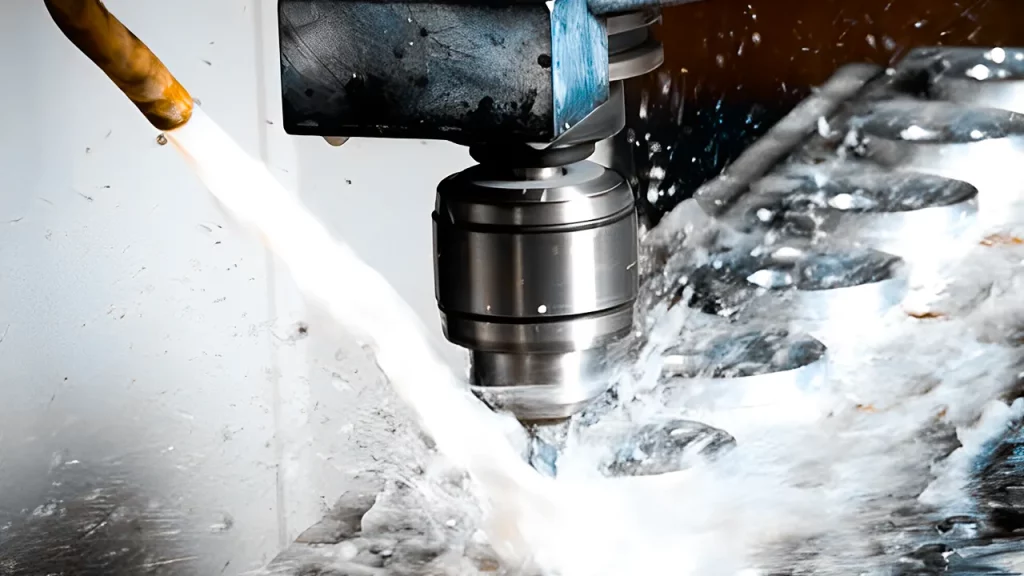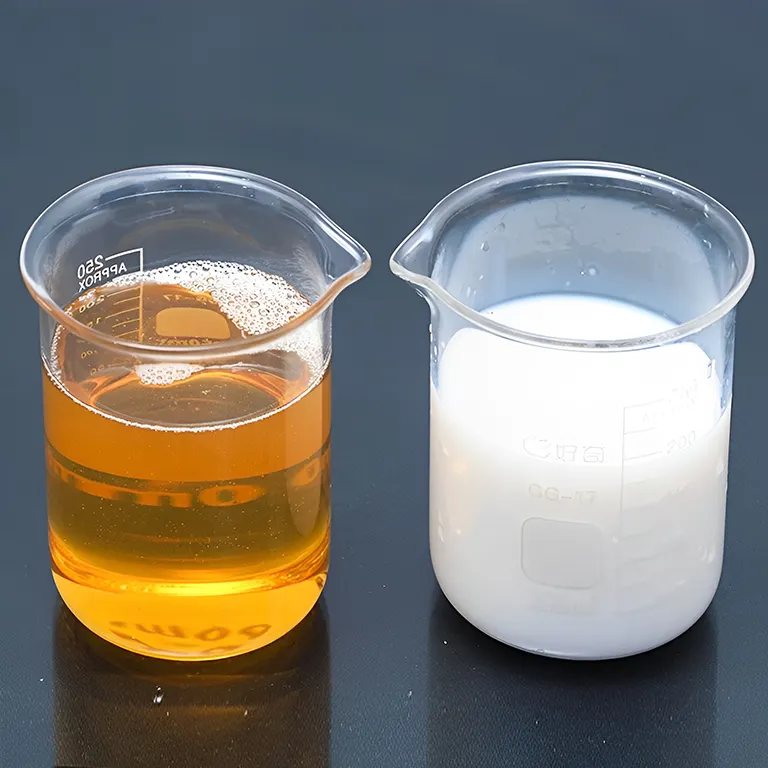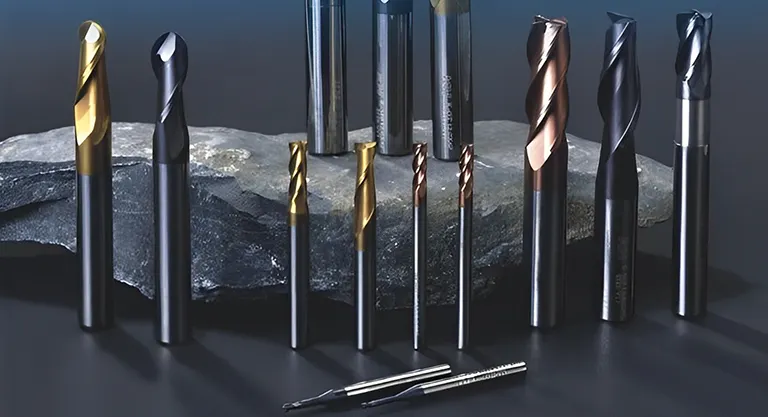During CNC machining, the nozzle near the cutting area ejects an oil-like liquid called cutting fluid.
This cutting fluid is a lubricant used in CNC-Maschinen for lubrication, cooling, and cleaning. As a result, cutting fluid is crucial in CNC machine automatic machining.
Now let’s explore cutting fluid, its types, and uses. This article will also explore the tips for picking the right cutting fluid for manufacturing. So stay tuned!

Verwandte Seiten: CNC-Gewindebearbeitung 101: Was ist das und wie funktioniert es?
What is a Cutting Fluid?
Cutting fluid is a type of industrial liquid used in metal cutting operations such as CNC machining to lubricate and cool the cutting tools and the metal being cut. Other names for this liquid include cutting oil, coolant, lubricant, and cutting compound.
Cutting fluid is often manufactured using petroleum distillates, animal fats, plant oils, water, air, or other essential ingredients. It is made up of several incredibly useful ingredients that have been scientifically combined so that they can perform effectively with one another.
Reducing fluid has much superior cooling capabilities than saponified oil since it does not have the drawbacks of a conventional soap-based emulsion, such as how simple it is to stink during the warmer months and how difficult it is to dilute during the colder months.
It is harmless, does not have a pleasant odor, is not hazardous to people or machinery, does not contribute to air pollution, and does not damage the paint on lathes. Additionally, it can be used for grinding and cutting ferrous steels.
Lesen Sie auch: Was ist die Schließeinheit in einer Spritzgießmaschine?
Properties of a High-Quality Cutting Fluid:
Some of the things a suitable cutting fluid should have are listed below:
- Thermal conductivity is a way to measure how well something moves heat. Hence, evaluating how well the cutting fluid can move to heat away from the subject and the tool is important.
- The more heat a cutting fluid can take in before it gets too hot or boils, the higher its heat capacity.
- Cutting fluids are easy to move because they have a low viscosity. It also stops gunk from forming when the chips are mixed with the fluid.
- Such cutting fluids shouldn’t hurt the tool or the thing you’re cutting.
- Quality cutting fluid must not only not be acidic but also keep parts from rusting and oxidizing.
- Since it will likely come into contact with people and the environment, a quality cutting fluid can’t harm either.
- Cutting fluids can’t cause chemical reactions when they come in touch with surfaces. Not only does this hurt the surfaces, but it also makes the fluid worse.
- A practical cutting fluid shouldn’t leave any smell on the machine or the part used to make it.
- A quality cutting fluid should be clear enough to see still what you are cutting.
- Such cutting fluids shouldn’t also break down quickly when it’s being used or when they are being kept.
Functions of Cutting Fluid During CNC Machining:
Lubrication
Cutting fluid can leave an oil film on the surface of workpieces and tools. This film can penetrate even the most minor metal gaps and irregular areas, which helps reduce the amount of friction between the metals. It is possible to produce the following effects:
- It reduces the amount of tool wear and increases its lifespan.
- Cutting fluid also reduces the resistance to cutting and decreases the amount of power used during the machining process.
- Burrs on the edges should be avoided, and the accuracy of the machined surface should be improved.
Cooling:
The temperature of the cutting fluid can reach as high as 600–1000 degrees Celsius, and it can lower the amount of heat generated during the cutting process.
Now it isn’t easy to dissipate heat, and as a result, the workpieces will grow heated. This holds particularly true for workpieces composed of low thermal conductivity materials, like stainless steel.
- Utilizing cutting fluid as a means to bring the temperature down has the potential to bring about the following effects:
- The amount of thermal distortion the cutter experiences is minimized, and its useful life is lengthened.
- In order to preserve the precision of the machining process, it is imperative to prevent thermal deformation of both the workpiece and the tool.
- It is possible to machine at a high pace.
Cleaning:
The chips created during the cutting process can be washed away, and the workpiece can be cleaned if cutting fluid is sprayed on it. This has the potential to bring about the following effects:
- It prevents chip adhesion from scratching the workpiece by using preventative measures.
- Cutting fluid also prevents flaws in the machining process caused by chip accumulation and blocking.
- Take precautions to avoid tool damage caused by chip entanglement.
Preventing Rust:
In addition to preventing rust from forming on the CNC machine and the work surface, cutting fluid also helps to extend the life of cutting tools by limiting the:
- Bordering wetness
- Air
- Sweat
How Many Types of Cutting Fluid Are Used in CNC Machining?
As mentioned earlier, the removal of debris, protection against corrosion, cooling, and lubrication are some of the essential jobs that cutting fluid does.
The need for the cutting fluid will change depending on the type of manufacturing operation that you are carrying out; as a result, you should select your cutting fluid on these shifting requirements.

Emulsions:
Emulsions are soluble oil that may be produced by combining water and mineral oil in a specific ratio (often between 1 and 20% oil to water). They can also be found in nature.
Additives are also included, such as sodium sulfonate, which helps oil and water mix together more effectively; anti-corrosion additives, which improve the corrosion-resistant features of the product; biocides, which inhibit the growth of bacteria; and anti-wear additives, which enhance the lubrication.
This cutting fluid is used when necessary to achieve rapid cooling, such as in high-velocity drilling, fräsen, Drehen, and grinding processes.
Emulsions are superior to synthetic cutting fluids in lubrication and anti-corrosion protection.
Pure Oils
Natural, unadulterated oils can come from either plants or animals. Consequently, cutting fluids made using them is considered kind to the environment.
They have great lubricating qualities and contain little to no water, making their resistance to rust even more impressive.
However, they are significantly more expensive than other cutting fluids because they are organic.
As a result, pure oils are not utilized in heavy cutting and drilling activities unless they are added as additives to other cutting fluids to increase lubrication.
Fluids Made From Synthetic Ingredients
Organic and inorganic chemical components are mixed with water to produce synthetic fluids. These certain additives enhance lubrication, reduce rust and corrosion, and increase overall performance.
The assistance of synthetic fluids can effectively facilitate the cooling of the work area and the efficient removal of chips.
As cutting fluids, semi-synthetic fluids are typically utilized. They are a combination of water-based, synthetic, and emulsion-based fluids. As a result, they possess qualities that are shared by emulsions and synthetic fluids.
Lesen Sie auch: Formkern: Was er ist und wie er sich von einem Formhohlraum unterscheidet
Using the Right Cutting Fluid On Different CNC Machining Tools:
Because different processing tools work in different ways, the materials that can be worked on with them are also different. This means that different types of cutting fluids are ideal for usage on different types of materials. Let’s go ahead and explore which cutting fluid works best on what materials.

Use different cutting fluids at different speeds
There isn’t much heat when cutting with tools made of high-speed steel at medium and low speeds, so you can use an oil-based cutting fluid or emulsion. Since a lot of heat is created when cutting at high speed, cutting fluid based on the water can be an excellent way to cool things down.
At this time, if an oil-based cutting fluid is used, a lot of oil mist will be made, which will hurt the environment and make it easy for the subject to get burned. This will lower the quality of the work and shorten the tool’s life. In addition, it is best to use extreme-pressure aqueous solutions or extreme-pressure emulsions during Schruppbearbeitung, and extreme-pressure emulsions or extreme-pressure cutting oils are perfect for finishing.
Likewise, medium-speed cutting is used on high-speed steel, which speeds about 70m/m. Furthermore, high-speed steel is an iron metal with added tungsten and chromium to make it harder and more wear-resistant. However, at temperatures above 600°C, high-speed steel’s hardness and wear resistance drop to an unacceptable level. But a cutting oil that dissolves in water can keep the machine’s temperature below 600°C.
Use of oil-based cutting fluids with low heat conductivity
Cemented carbide tools are more likely to chip if heated and cooled quickly, so they should be heated and cooled as evenly as possible. So, oil-based cutting fluids with low heat conductivity and the right amount of anti-wear additives are usually used.
When cutting quickly, hit the tool with a lot of cutting fluid to ensure it doesn’t heat up in different places. And this way works well to lower the temperature and reduce the amount of oil mist.
Cutting fluids for cutting environments in chrome, cobalt and tungsten materials
Chrome, cobalt, and tungsten metals are poured The non-ferrous elements that make up these metals are based on cobalt. When heated to more than 600°C, it becomes stronger and more wear-resistant than high-speed steel.
This can be used for high-speed cutting, as well as for metal that is hard to cut and cutting jobs that create a lot of heat. Cast metals are susceptible to significant changes in temperature, like when cutting stops all of a sudden. They are better for stable cutting jobs and can use cutting oil that dissolves in water.
Cutting fluids for ceramic and diamond tools
Because ceramic and diamond tools wear better at high temperatures than cemented carbide tools, they often use dry-cutting methods. Sometimes, a water-based cutting fluid with better thermal conductivity is poured continuously and entirely over the cutting area to keep the temperature from getting too high.
Cutting fluids for carbides tools
Carbides are used a lot in the business of making metals. Most of the time, these materials are called cemented carbides or super-hard metals. They are made by putting tungsten, titanium, niobium, and tantalum carbide powder into a cobalt mold and heating it to a high temperature. Different types of cemented carbides can be made by changing the amount and type of metal carbides.
Cemented carbide is used because even at 1000°C, it is still hard and doesn’t wear down easily. Most of the time, they are used as plugs or cutting heads that can be changed. Each head is shaped and turned differently. It can be restored and put away based on what you need. Putting a carbide layer on the cutting tool head is another easy way to make them.
The standard carbide tool is covered with titanium carbide, which is how it is made. With this method, the head of the cutter is hard to wear down, and the cutter itself is hard to break. Carbide tools are often used with cutting oils that can be washed off with water, but they must be chosen carefully. Some additives will cause the metal that covers the cobalt to rust.
Cutting fluids for Ceramic and diamond-ceramic cutting tools
Ceramic and diamond-ceramic cutting tools are mostly made of alumina, which keeps them hard and resistant to wear even at high temperatures. But, as we’ve already said, the harder a material is, the more fragile it is.
This means ceramic tools aren’t good for cutting in a way that isn’t constant or has shock loads or temperature changes. You can use oil-based cutting oil or no cutting oil at all when doing grinding. Water-soluble cutting oil should be avoided.
Cutting fluids for diamond-cutting tools
A diamond is the hardest tool for cutting, but it is also very fragile. Diamonds can be used to work with high-content aluminum, which has hard bits of silicon and will quickly wear down carbide tools. It can also be used to grind and process things not made of iron, like stone and cement.
High temperatures can cause the diamond to oxidize, so it can’t be used in metals that are hard to work with. Since it is very hard, it is often used to grind other things. You can use oil-based cutting oil that dissolves in water or synthetic cutting fluid.
—
Still unsure which cutting fluid is ideal for cutting a certain product during CNC machining for manufacturing your business products? Connect with our professional technicians at Prototool.com for expert guidance.










